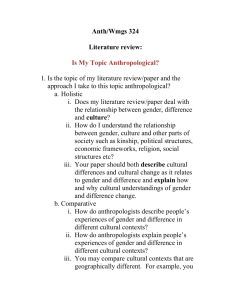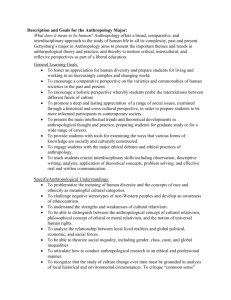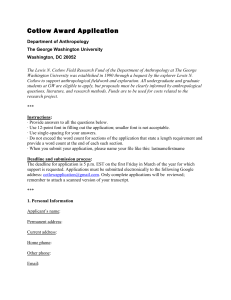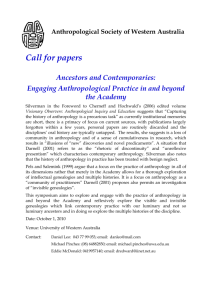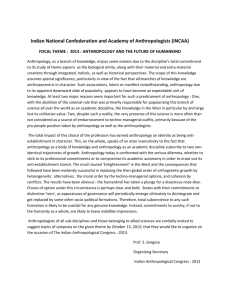John H - Ning.com
advertisement
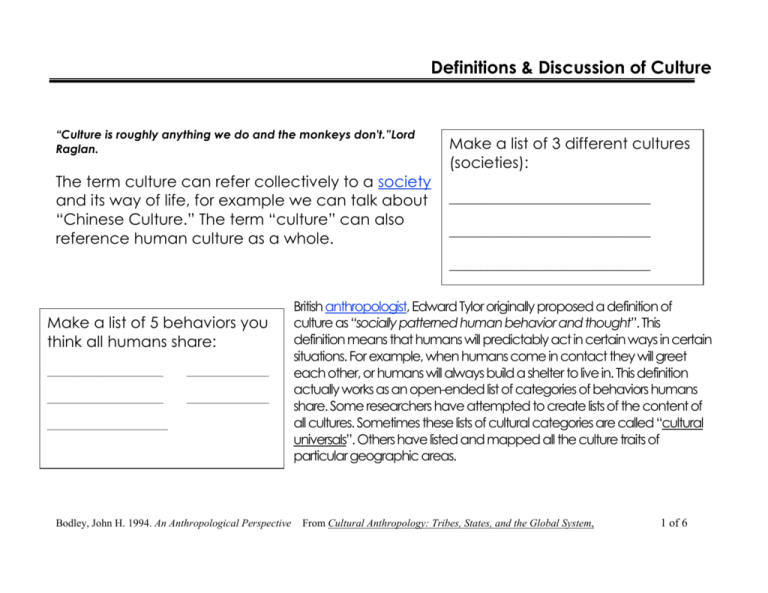
Definitions & Discussion of Culture “Culture is roughly anything we do and the monkeys don't.”Lord Raglan. The term culture can refer collectively to a society and its way of life, for example we can talk about “Chinese Culture.” The term “culture” can also reference human culture as a whole. Make a list of 3 different cultures (societies): __________________________ __________________________ __________________________ Make a list of 5 behaviors you think all humans share: ________________________ _________________ ________________________ _________________ _________________________ British anthropologist, Edward Tylor originally proposed a definition of culture as “socially patterned human behavior and thought”. This definition means that humans will predictably act in certain ways in certain situations. For example, when humans come in contact they will greet each other, or humans will always build a shelter to live in. This definition actually works as an open-ended list of categories of behaviors humans share. Some researchers have attempted to create lists of the content of all cultures. Sometimes these lists of cultural categories are called “cultural universals”. Others have listed and mapped all the culture traits of particular geographic areas. Bodley, John H. 1994. An Anthropological Perspective From Cultural Anthropology: Tribes, States, and the Global System, 1 of 6 The first inventory of cultural categories was undertaken in 1872. A committee of anthropologists prepared a manual that listed seventy-six culture topics, in no particular order, including such diverse items as cannibalism and language. The most exhaustive such list is the "Outline of Cultural Materials," first published in 1938 and still used as a guide for cataloging worldwide cultural data for cross-cultural surveys. Like the table of contents of a giant encyclopedia, the outline lists 79 major divisions and 637 subdivisions. For example, "Food Quest" is a major division with such subdivisions as collecting, hunting, and fishing. Think about our “American Culture” add two subdivisions of “Food Quest” that fit our society. The problem with defining culture is that many anthropologists disagree on the exact definition. For example, in 1952 Alfred Kroeber and Clyde Kluckhohn, American anthropologists, published a list of 160 different definitions of culture. A simplified list of their definitions is on the table below, their list indicates the diversity of theories about culture. The definition of culture one uses is an important matter because it may influence the research problems they investigate, how they think about what they learned and the positions they take on issues. Bodley, John H. 1994. An Anthropological Perspective From Cultural Anthropology: Tribes, States, and the Global System, 2 of 6 TABLE: Diverse Definitions of Culture: Culture consists of everything on a list of topics, or categories, such as social organization, religion, or economy Historical: Culture is social heritage, or tradition, that is passed on to future generations Behavioral: Culture is shared, learned human behavior, a way of life Normative: Culture is ideals, values, or rules for living Culture is the way humans solve problems of adapting to the environment or Functional: living together Culture is a complex of ideas, or learned habits, that inhibit impulses and Mental: distinguish people from animals Structural: Culture consists of patterned and interrelated ideas, symbols, or behaviors Symbolic: Culture is based on arbitrarily assigned meanings that are shared by a society Topical: Which statements best fit with the different definitions above. A people without the knowledge of their past history, origin and culture is like a tree without roots. Culture is roughly anything we do and the monkeys don’t. Moral values, and a culture and a religion, maintaining these values are far better than laws and regulations. How can a society that exists on instant mashed potatoes, packaged cake mixes, frozen dinners, and instant cameras teach patience to its young? Bodley, John H. 1994. An Anthropological Perspective From Cultural Anthropology: Tribes, States, and the Global System, 3 of 6 Culture involves at least three components: 1) what people think or believe, 2) what they do, and 3) the material products they produce. Think about the game we played. What were the 3 beliefs the people had? Give an example how their actions demonstrated their beliefs. 1._______________________________________ 2.______________________________ 3. __________________________ _________________________________________________________________________________________________________ _________________________________________________________________________________________________________ Some anthropologists would define culture entirely as mental rules (what people think) guiding behavior. Sometimes however, the rules people say they follow and how they actually act does not always match. Consequently, some researchers pay most attention to human behavior and its material products. Think about school. List a belief we have in school. (For example school is for learning or gum chewing is not allowed). Give an example of how our behaviors do not match our beliefs. Bodley, John H. 1994. An Anthropological Perspective From Cultural Anthropology: Tribes, States, and the Global System, 4 of 6 Culture also has six properties: it is shared, learned, symbolic, transmitted from one generation to the next, adaptive (how it changes over time and place), and integrated (how it is part of our daily lives). For something to be cultural it must be shared among many people. If it is something that just one or two people believe then it is not cultural, it is idiosyncratic. Culture is learned, not biologically inherited, and involves arbitrarily assigned, symbolic meanings. For example, Americans are not born knowing that the color white means purity, and indeed this is not a universal cultural symbol. In some cultures white signifies death. Ask Madame Bowen if there are symbols that mean something different in France than they do in the U.S. Remember that culture is beliefs, behaviors and things humans make and that they are not idiosyncratic. Look at each of the properties below and give an example of each one: Shared Learned Adaptive Bodley, John H. 1994. An Anthropological Perspective From Cultural Anthropology: Tribes, States, and the Global System, Integrated 5 of 6 Draw a cultural symbol The human ability to assign arbitrary meaning to any object, behavior or condition makes people enormously creative and readily distinguishes culture from animal behavior. People can teach animals to respond to cultural symbols, but animals do not create their own symbols. Furthermore, animals have the capability of limited tool manufacture and use, but human tool use is extensive enough to rank as qualitatively different and human tools often carry heavy symbolic meanings. Bodley, John H. 1994. An Anthropological Perspective From Cultural Anthropology: Tribes, States, and the Global System, 6 of 6

